Every free moment I get now, I'm out pruning roses. This month I am working on my portlands, hybrid perpetuals, hybrid musk, and polyanthas. While I was outside pruning today, my oldest son--my most observant and handy child in the garden--asked me, "Why do you prune them?" What a great question. If we think about why we're pruning, it will help us to get the most out of the job.
~
Pruning for Size
~ First, I prune to control the size of my roses. One of the criticisms against old roses is that they take up too much space compared to modern ones. Yet, you can grow them as smaller shrubs. The Reeves-Reed Arboretum (http://www.reeves-reedarboretum.org/) in Summit, New Jersey has a great collection of old roses in a small space. I observed that they prune these roses by half each year which keep them to a size of about 3 feet by 3 feet, instead of the usual 5 by 6. In my garden, I grow Russell's Cottage (http://heirloomgardener.blogspot.com/2007/12/seven-sisters-rose.html, pictured above). It is reported to grow to between 6 to 12 feet high with equal girth. By pruning, I have kept it to about 4 feet tall and 3 feet wide.
First, I prune to control the size of my roses. One of the criticisms against old roses is that they take up too much space compared to modern ones. Yet, you can grow them as smaller shrubs. The Reeves-Reed Arboretum (http://www.reeves-reedarboretum.org/) in Summit, New Jersey has a great collection of old roses in a small space. I observed that they prune these roses by half each year which keep them to a size of about 3 feet by 3 feet, instead of the usual 5 by 6. In my garden, I grow Russell's Cottage (http://heirloomgardener.blogspot.com/2007/12/seven-sisters-rose.html, pictured above). It is reported to grow to between 6 to 12 feet high with equal girth. By pruning, I have kept it to about 4 feet tall and 3 feet wide.
~
The key to old shrub roses is accepting that these roses are really tough. They have survived this long because they can regenerate themselves and resist disease. It took awhile, but now I am no longer afraid of cutting them way back. By doing so, I get to enjoy a greater variety of roses in a small space.
~
Pruning for Blooms
~
Second, I prune my repeat bloomers to stimulate growth and better, more continual blooming. The early spring pruning gets rid of thin, unproductive wood in the roses which drain energy away from flower production. The rule of thumb is that you should cut out any growth less than the diameter of a pencil. I also find it helpful to ask myself if the branch could support a rose blossom. If not, then prune it out. Lastly, remember that the stems as they come off the prior branch get smaller and smaller. If there is doubt about rather to keep something or not, ask yourself if the branch which comes off of it is too small to be productive. Very rarely will you regret pruning out questionable wood.
~ Without needing to sustain the wood you remove, the rose can give more energy to blooming. Oftentimes, if a repeat blooming rose goes a season where the blooming seems less prolific, cutting it back by half will remedy the situation. I find that portlands, in particular, need a firm pruning hand every three to four years. As they get larger, the frequency of their flushes decreases. With lots of young wood, shrubs like Rose de Rescht (http://heirloomgardener.blogspot.com/2007/11/rose-de-rescht.html, pictured above) and Jacques Cartier (a.k.a. Marchesa Boccella, pictured below), will bloom almost continuously from June to October.
Without needing to sustain the wood you remove, the rose can give more energy to blooming. Oftentimes, if a repeat blooming rose goes a season where the blooming seems less prolific, cutting it back by half will remedy the situation. I find that portlands, in particular, need a firm pruning hand every three to four years. As they get larger, the frequency of their flushes decreases. With lots of young wood, shrubs like Rose de Rescht (http://heirloomgardener.blogspot.com/2007/11/rose-de-rescht.html, pictured above) and Jacques Cartier (a.k.a. Marchesa Boccella, pictured below), will bloom almost continuously from June to October.
~ While removing the unproductive wood, all dead and damaged wood should also be removed. This wood can harbor disease and will take energy away from the shrub. Finally, you can cut away branches that are congesting the center of your shrub. It is good to lighten it up so that air may easily pass through.
While removing the unproductive wood, all dead and damaged wood should also be removed. This wood can harbor disease and will take energy away from the shrub. Finally, you can cut away branches that are congesting the center of your shrub. It is good to lighten it up so that air may easily pass through.
~
With these two main ideas in mind, my pruning is directed and it's easier to know what cuts to make: I prune to keep the rose in its allotted space and to direct more of the plant's energy to make big, beautiful blooms that keep on coming.
~
For "How to Prune Roses, Part I: An Introduction" click here: http://heirloomgardener.blogspot.com/2008/02/how-to-prune-roses-part-i-introduction.html.
~
For "How to Prune Roses, Part II: Old Rose Pruning Secrets" click here:
http://heirloomgardener.blogspot.com/2008/03/how-to-prune-roses-part-ii-old-rose.html.










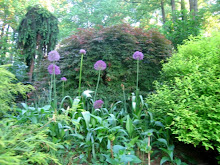
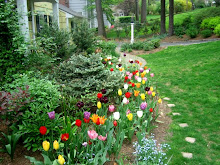
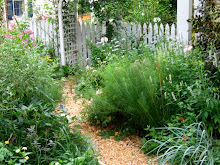
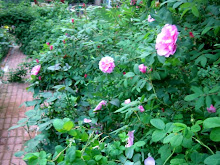

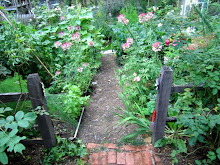

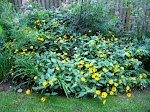





3 comments:
Nice tutorial, Heirloom Gardener. And I'm glad to hear you have a child who enjoys helping you in the garden.
Thank you so much for all the rose pruning information, I can't wait to use all of your wonderful tips as soon as the snow melts :)
Wow! I'm going to have come back and visit when I have time to read more! I love my roses, but I'm still a newbie gardener.
Post a Comment